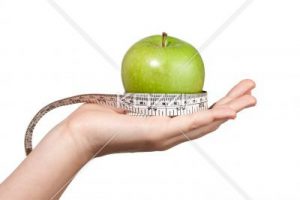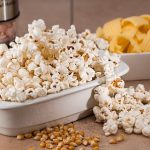by Marie Arick | Feb 14, 2017

Knowing your waist circumference is a simple way to determine if you are at risk for heart disease. A waist circumference larger than 40 inches for men or 35 inches for women deems a person overweight per National Institute of Health (NIH) guidelines.
It is commonly known that being overweight is associated with a barrage of health problems such as heart disease, hypertension, diabetes, and even some cancers. Where those extra pounds are carried is important to note. When those pounds are concentrated around the waist, it “is an indicator of the level of internal fat deposits which coat the heart, kidneys, liver, digestive organs and pancreas” according to the Heart Foundation, versus carrying those extra pounds on your thighs and/or hips.
Waist circumference is a good indicator to utilize. It has been discovered in many cases that Body Mass Index (BMI) can overestimate body fat in certain people with high amounts of muscle mass. According to the NIH, “the good news is even a small weight loss, between 5 and 10 percent of your current weight, will help lower your risk of developing diseases.” Weight loss should be conducted in a healthy manner and incorporate physical activity. The Choose MyPlate website provides free exercise and dietary tracking and great practical information to aid in one’s journey.
The really simple way to predict your risk for heart disease can be as easy as measuring your waist. Taking a few moments to complete this task can be an enlightening step in managing your health and possibly prevent you from ‘waisting’ your heart away.
by Laurie Osgood | Feb 14, 2017
February has been designated National Snack Month by the Snack Food Association of America, and the National Potato Promotion Board.
As Americans, the one thing that we can all agree on is our love of snacks. Snack sales in the United States top $60 Billion annually. The snack foods that we tend to reach for can be loaded with calories, sugar, sodium and fat. However, snack foods do not have to be unhealthy to satisfy your cravings. When you need a little boost of energy during the day, a healthy snack can do the trick.
According to University of Florida’s Karla Shelnutt, Associate Professor and Extension Nutrition Specialist, and Julie Martinez, healthy snacking is an important part of a child’s daily intake. The key is to learn how to make healthy snack choices and to avoid consuming too many snacks high in sugar and salt, and low in healthy nutrients (http://edis.ifas.ufl.edu/topic_snacks ).
The key to healthy snacking is to plan ahead. Keep a variety of tasty, healthy snacks on hand to help to tide your family over in between meals. When shopping for your family, remember to select healthier items such as fresh fruits and vegetables and make sure to read food labels when selecting pre-packaged snacks.
Additional healthy snacking ideas:
- Cut back on the high-calorie snacks. Choose fruits, vegetables and whole grains, like popcorn.

- Snack when you are hungry, not when your are bored or stressed. Know the difference!
- Eat sensible portion sizes; use single serve containers for snacks.
- Quench your thirst with water, instead of high sugar drinks.
Healthy snack suggestions:
- Ants on a log — Peanut butter filled celery sticks, topped with raisins.
- Healthy ice pops — Pour 100% juice into ice cube trays and freeze.
- Slices of apple with peanut butter
- Smoothies with fat-free milk and frozen strawberries
- Yogurt and fresh fruit
- Crackers and cheese sticks
For more information on the importance of healthy snacking, contact your Family and Consumer Science Agent at your local UF/IFAS Extension Office.
Sources:
Raising Healthy Children: The Role of Snacking. Julie M. Martinez and Karla P. Shelnutt. UF/IFAS EDIS, FCS8902/FY1154. http://edis.ifas.ufl.edu/topic_snacks
Academy of Nutrition and Dietetics. http://www.eatrightpro.org/resource/media/press-releases/national-nutrition-month/during-nnm-make-sensible-snacks-part-of-your-healthy-eating-planpro-press-release
by Laurie Osgood | Jan 27, 2017
It’s that time of year again – time to make resolutions designed to improve your life to become a happier, healthier, and wealthier person. Unfortunately, some resolutions are not realistic and set us up for failure from the start. A very small percentage of us manage to maintain these lofty resolutions.
However, there are small changes you can make today that can help you enjoy a healthy lifestyle. You can start by simply reading the nutrition fact labels on your favorite foods. Smart dietary choices include eliminating or cutting back on these 5 commonly used food items.

- Added Sugar: Some foods, such as milk (lactose) and fruits (fructose), naturally contain sugars. Added sugars (like sucrose and high fructose corn syrup) are added to prepared foods and drinks. Many prepared and processed foods are stocked with added or refined sugars for supplemental sweetness. Added sugars are often called “empty” calories, because they contain extra calories and few or no vitamins and minerals, and can lead to extra pounds or even obesity, thereby reducing heart health. Alternatives: Instead of eating foods with a lot of added sugar, try a piece of fruit or use other options such as raw honey, Stevia or maple syrup.
- Sodium: is found in many processed foods, and is commonly known as salt. Excess sodium increases blood pressure because it holds excess fluid in the body, and that creates an added burden on the heart. Too much sodium will increase your risk of stroke, heart failure, osteoporosis, and some cancers. Alternatives: You can reduce the amount of sodium in your diet by limiting the amount of salt you add to your foods, avoiding processed foods, and by choosing “reduced sodium,” “no sodium added,” or “low sodium” options when available. Try experimenting with fresh or dried herbs/seasonings to flavor to foods without adding salt.
- Enriched Flour: this ingredient is included in many of the processed foods that we eat including pasta, cereals and breads. Whole grain flours are often stripped of their nutrients. Then, to be considered enriched, vitamins, sugar, and other additives are added back in. Alternatives: Instead of white bread, pasta or rice, choose whole grain products instead.
- Saturated Animal Fats: this type of fact, in the form of lard, butter, eggs, cheese, and tallow come primarily from animals and are known to cause health issues such as high cholesterol and heart disease. Minimizing intake of unhealthy fats allows you to reduce calorie intake in a healthy manner. Unsaturated fats offer important health benefits and should be included in everyone’s diet. Alternatives: A simple alternative to saturated fats in your diet can be unsaturated fats found in non-animal, plant products such as fruits & vegetables, oils, nuts and seeds.
- Hydrogenated Oils; commonly called Trans fats, or Trans Fatty Acids. Hydrogenation is the process of converting a pourable oil into a more solid, saturated fat, and is often added to a product in order to extend its shelf life. Partially or fully hydrogenated oils promote cardiovascular diseases by raising your bad (LDL) cholesterol levels and lowering your good (HDL) cholesterol levels. Alternatives: Choose oils that are high in polyunsaturated and monounsaturated fat, such as olive, safflower and peanut oils. Another healthy alternative to hydrogenated oil is Omega- 3 oils from fish. Also, try broiling foods instead of frying.
Overly ambitious New Year’s Resolutions often fail because they require major changes in a very short amount of time, making them almost impossible to stick with. Instead of broad, life changing goals, your New Year’s Resolution should include small lifestyle changes, such as starting with cutting back on or eliminating these 5 items.
Resources:
University of Florida IFAS Extension;
http://edis.ifas.ufl.edu/fy1400
American Heart Association:
http://www.heart.org/HEARTORG/HealthyLiving/HealthyEating/Nutrition/Added-Sugars_UCM_305858_Article.jsp#.WG1D0k0zWLw
USDA Choose MyPlate.gov:
https://www.choosemyplate.gov/myplate-mywins
Footnotes:
Laurie B. Osgood, Family and Consumer Sciences Agent, Gadsden County Extension, UF/IFAS Extension, Quincy, FL 32351 (850) 662-3287 Osgoodlb@ufl.edu
The Institute of Food and Agricultural Sciences (IFAS) is an Equal Opportunity Institution authorized to provide research, educational information and other services only to individuals and institutions that function with non-discrimination with respect to race, creed, color, religion, age, disability, sex, sexual orientation, marital status, national origin, political opinions or affiliations. For more information on obtaining other UF/IFAS Extension publications, contact your county’s UF/IFAS Extension office.
U.S. Department of Agriculture, UF/IFAS Extension Service, University of Florida, IFAS, Florida A & M University Cooperative Extension Program, and Boards of County Commissioners Cooperating. Nick T. Place, dean for UF/IFAS Extension.
by Heidi Copeland | Jan 23, 2017
 In the early 70’s Gary Iskowitz, was doing graduate work as well as teaching tax law while working for the Internal Revenue Service (IRS) agency. Mr. Iskowitz saw a growing problem with questionable tax preparers who were scamming low-income people in his area. He did not like what he saw! Consequently, he proposed that he train a minimal number (10) of likeminded student volunteers to go into the community to prepare free tax returns for underserved residents. People lined up around the block waiting for them.
In the early 70’s Gary Iskowitz, was doing graduate work as well as teaching tax law while working for the Internal Revenue Service (IRS) agency. Mr. Iskowitz saw a growing problem with questionable tax preparers who were scamming low-income people in his area. He did not like what he saw! Consequently, he proposed that he train a minimal number (10) of likeminded student volunteers to go into the community to prepare free tax returns for underserved residents. People lined up around the block waiting for them.
The following year, almost 100 students were recruited and trained to prepare free tax returns for low-income residents. The rest, they say, is history!
This college-volunteer effort significantly strengthened the Volunteer Income Tax Assistance (VITA) program. Now, more than 40 years later, VITA is still going strong.
VITA is still designed to promote and support free tax preparation service for the underserved, in both urban and non-urban locations. Service is targeted to low-to-moderate income individuals, persons with disabilities, the elderly, and limited English speaking.
Why? Just as in Gary Iskowitz’ time, this program is an effort to provide both a valuable community service and a powerful learning experience for the participants. Not only does a tax payer get their taxes done for free, the local community benefits from the monies spent by the tax payer. Plus, the IRS is pleased because citizens are in compliance with federal law.
Volunteers come from the local communities they serve.
If you plan to take advantage of any of the VITA programs this year, be sure to bring the proper documentation. A return cannot be prepared without the appropriate certification.
And know that in an effort to stop fraudulent tax return payments, beginning in 2017, if you claim the Earned Income Tax Credit (EITC) or Additional Child Tax Credit (ACTC) on your tax return, the IRS must hold your refund until at least February 15 — even the portion not associated with EITC or ACTC.
What to Bring to Your Local VITA Site:
- Proof of identification (photo ID)
- Social Security cards for you, your spouse and dependents on the tax return or a Social Security number verification letter issued by the Social Security Administration
- An Individual Taxpayer Identification Number (ITIN) assignment letter may be substituted for you, your spouse and your dependents if you do not have a Social Security number
- Proof of foreign status, if applying for an ITIN
- Birth dates for you, your spouse and dependents on the tax return
- Wage and earning statements (Form W-2, W-2G, 1099-R,1099-Misc) from all employers
- Interest and dividend statements from banks (Forms 1099)
- A copy of last year’s federal and state returns, if available
- Proof of bank account routing and account numbers for direct deposit such as a blank check
- To file taxes electronically on a married-filing-joint tax return, both spouses must be present to sign the required forms
- Total paid for daycare provider and the daycare provider’s tax identifying number such as their Social Security number or business Employer Identification Number
- Forms 1095-A, B or C, Affordable Health Care Statements
Start 2017 off right! Being well-organized and getting your information together can save you a lot of time and maybe even money!
by Melanie Taylor | Jan 6, 2017
 January’s grain of the month is OATS. Americans buy more oats at this time of year than in any other month – and January has long been celebrated as National Oatmeal Month.
January’s grain of the month is OATS. Americans buy more oats at this time of year than in any other month – and January has long been celebrated as National Oatmeal Month.
Oats at a Glance
Samuel Johnson’s 1755 dictionary defined oats as “A grain, which in England is generally given to horses, but in Scotland appears to support the people.” The Scotsman’s retort to this was, “That’s why England has such good horses, and Scotland has such fine men!” Oats (Avena sativa) have a sweet flavor that makes them a favorite for breakfast cereals. Unique among the most widely-eaten grains, oats almost never have their bran and germ removed in processing. So, if you see oats or oat flour on the label, relax; you’re virtually guaranteed to be getting whole grain.
In the U.S., most oats are steamed and flattened to produce rolled oats, sold as “old-fashioned” or regular oats, quick oats, and instant oats. The more oats are flattened and steamed, the quicker they cook – and the softer they become. If you prefer a chewier, nuttier texture, consider steel-cut oats, also sometimes called Irish or Scottish oats. Steel-cut oats consist of the entire oat kernel (similar in look to a grain of rice), sliced once or twice into smaller pieces to help water penetrate and cook the grain. Cooked for about 20-30 minutes, steel-cut oats create a breakfast porridge that delights many people who didn’t realize they love oatmeal!
Health Benefits of Oats
Scores of studies have documented the many health benefits of oats:
- Eating oats helps lower LDL “bad” cholesterol and may help reduce the risk of heart disease.
- Oats help you feel fuller longer, which helps control your weight.
- Oatmeal and oats may help lower blood pressure.
- Oats may help reduce your risk of type 2 diabetes, since their soluble fiber helps control blood sugar.
- Oats help cut the use of laxatives without the side effects associated with medications.
- Oats are high in beta-glucans, a kind of starch that stimulates the immune system and inhibits tumors. This may help reduce your risk of some cancers.
- Early introduction of oats in children’s diets may help reduce their risk of asthma.
- Oats are higher in protein and healthy fats and lower in carbohydrates than most other whole grains.
- Oats contain more than 20 unique polyphenols called avenanthramides, which have strong anti-oxidant, anti-inflammatory, and anti-itching activity.
Meal Ideas
Think oats are limited to breakfast cereals, cookies, and snack bars? Think again! Oats can be used in place of bread crumbs in meatloaf and hamburgers, in side dishes, and as a crispy coating. Check out these recipes for healthy, new ways to use oats:
For additional oat recipes you may want to try at home, visit: http://wholegrainscouncil.org/
Source: Whole Grains Council at http://wholegrainscouncil.org/





